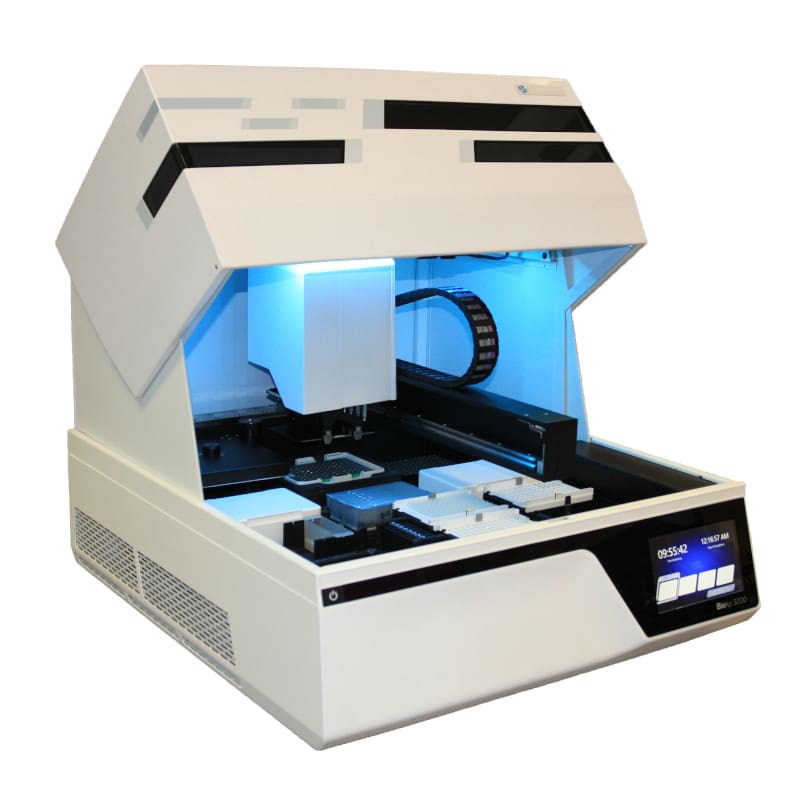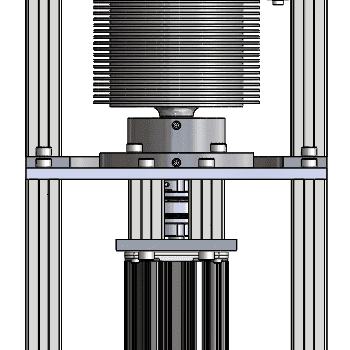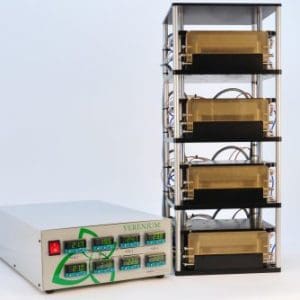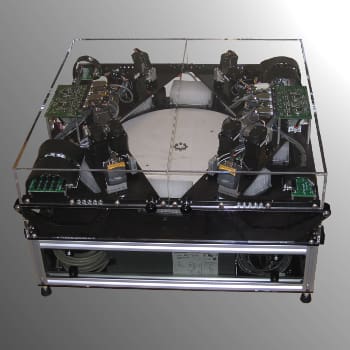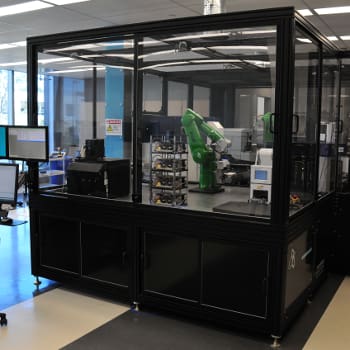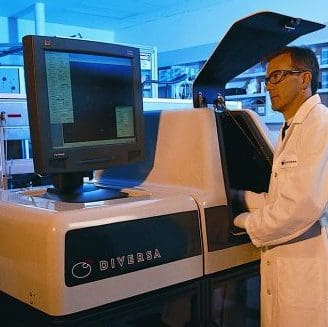AUTOMATING A LABOR-INTENSIVE PROCESS IN THE FIELD
THE CLIENT’S NEED

Diversa Corporation (now Verenium), a company that specialized in the development of high-performance enzymes, had a contract to develop an automated leaf sampling system for Syngenta, a multi-national corporation that produced seeds for commercial crops. They contracted with NOVO for the electromechanical and embedded software development. The automated sample collection system was intended to replace Syngenta’s existing process, which was entirely manual and labor-intensive.
Sample collection is one of the steps in the larger process of developing new commercial seed products using marker-assisted selection methods. The process required field technicians to stoop or crawl in the dirt between rows of new crops and tear off bits of leaf using tweezers, then manually insert the sticky leaf fragments into tiny wells in a microtiter plate. The elements—rain, wind, heat, and dirt—added to the discomfort of field technicians. Samples had to be traceable back to the donor plant as much as several weeks later based on whether genetic markers for desirable traits were detected during assays or sequencing processes.
The client needed an automated system for sample collection that was:
- Cost-effective
- Able to track samples from collection, through processing, and back to the donor plant
- Robust and fault-tolerant
- Simple and quick to use by field techs of varying skill levels
- Suitable for multiple plant species, field conditions, and climate zones
- Easily interfaced to existing LIMS software and laboratory instrumentation
TECHNICAL CHALLENGES: SAMPLE COLLECTION SYSTEM
The technical challenges were numerous on this project. Environmental factors and the need to lyophilize the samples within the cassettes required careful consideration of materials and methods to seal out dust, dirt, and moisture. Leaf fibrosity and sticky secretions had to be dealt with when leaves were initially collected, and the friability of the samples accounted for after lyophilization. Cross-contamination between samples had to be prevented. There was a need to interface with multiple stakeholders and with existing software and hardware systems. Sample tracking and collection had to be robust, fault tolerant, and intuitive. The human factors and usability requirements placed size and weight constraints on the design. The system needed to be ruggedized for shock due to accidental drops and rough usage. Manufacturability had to remain top of mind to meet cost goals.
THE ENGINEERING BEHIND GREAT PRODUCTS
NOVO engineers worked on the system from concept through transfer to manufacturing, including several hardware generations and verification testing cycles. The client deployed the system internally, realizing significant improvements in throughput for their sample processing. The final configuration included a power supply tote with a custom battery pack, a small ruggedized computer for interfacing with the client’s LIMS software and managing sample tracking, and a handheld device that collected samples and read barcodes on the plants. Interchangeable, consumable cassettes for sample containment were mounted to the handheld devices.

The proprietary, consumable cassette was at the heart of the system. Cassettes contained a large number of individual sample containers circulating in a track. Materials and geometries were optimized to allow precise positioning and indexing of the containers. The cassette and container design had to include features that minimized cross-contamination between samples. Plastic parts were designed to allow automated assembly methods. Automated equipment was developed for reformatting samples from the proprietary cassettes into standard microplates and for cleaning the cassettes for future reuse.
The durable device incorporated the mechanical drive for the cassette, barcode scanning, user interface, sensors to detect the condition of the cassette, and an electromechanical punching system. A custom actuator to drive the punch mechanism was required to generate the necessary forces. The punch mechanism incorporated a unique means for dislodging the leaf slug, as well as an internal lubrication system to prevent leaf secretions from clogging the mechanism. A series of micro-valves regulated fluid delivery to the punch mechanism from the pressurized supply in the system hub. Shock mounting and sealing methods were incorporated into the design for shock and moisture resistance.
The system hub incorporated a custom power supply and gel battery pack sized for a full day of use, as well as a fluid reservoir for punch lubrication. A hybrid cable incorporating signal, power, and fluid interfaced the durable to the system hub, which was carried in a belt or backpack worn by the field technician.
To use the system, field managers configured settings on the compact computer to collect multiple samples per plant, or to adapt to bar code schema for different plant numbering systems in the field or greenhouse. Workers then scanned a new cartridge and the bar code of the plant they were to sample and began sampling according to the configured settings. Throughout the day, the system was able to provide error messages when errors were detected, and also retrieve information on the last scanned plant in the event that a worker had to change tasks or was otherwise interrupted.
NOVO provided system architecture, mechanical design, electronics hardware design, and firmware development for the design and manufacture of this system. NOVO’s robust infrastructure, particularly the on-site machine shop, supported the fast turnarounds and complete client support this project required.
This design resulted in multiple U.S. utility patents, including 8 758 638 and 7 980 148.

